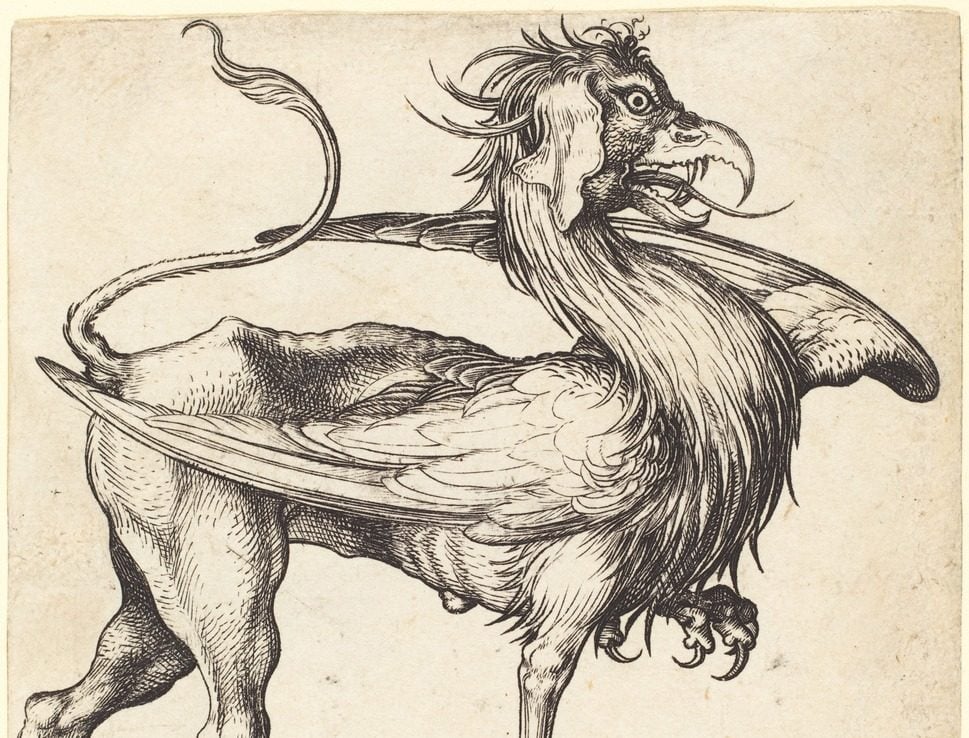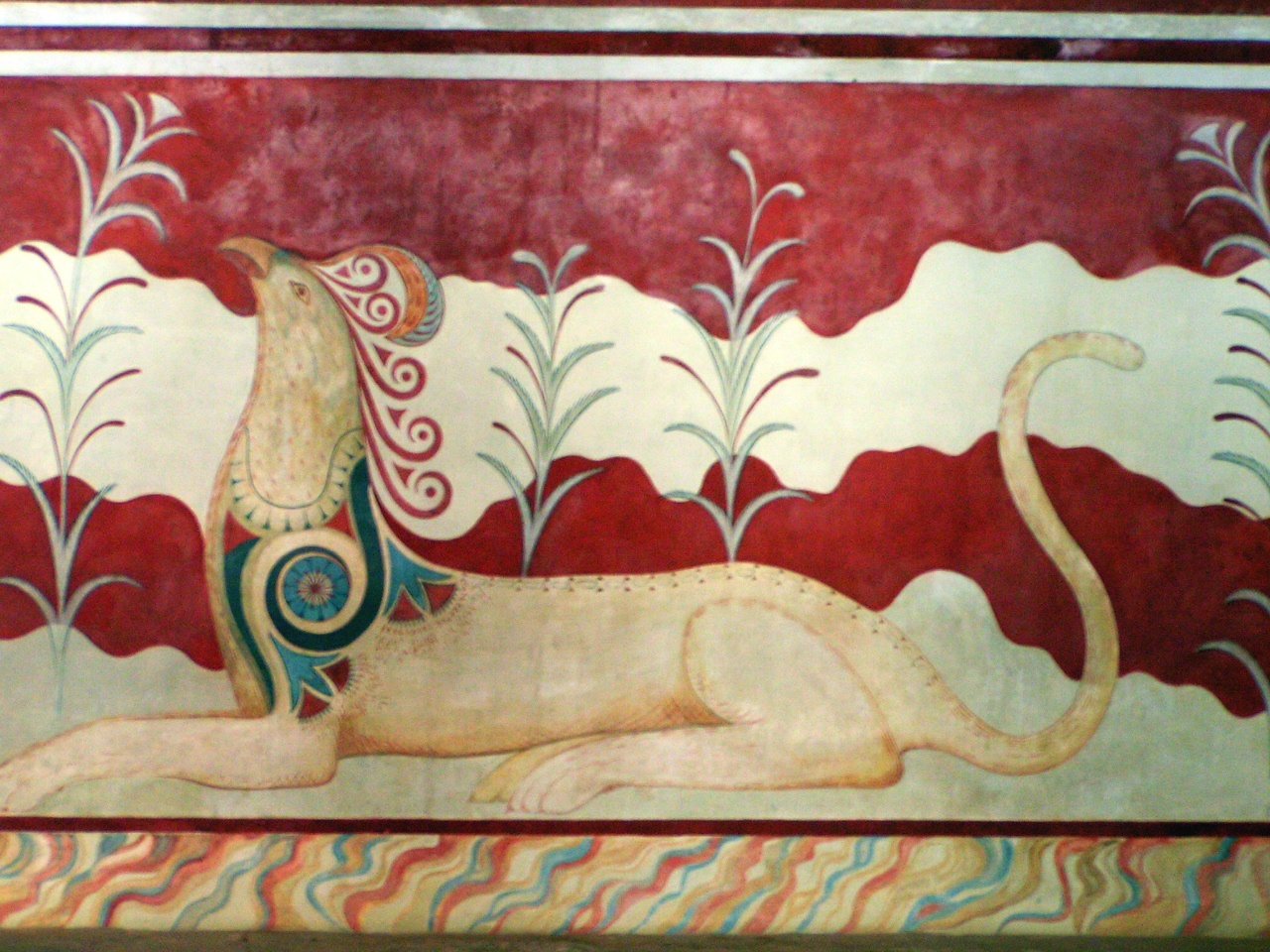
Greek mythology is full of incredible beasts and monsters. The griffin is one such example of a famous mythological animal from ancient Greece. It had the body of a lion but the head and wings of an eagle. Obviously, this creature did not truly exist. However, there are various examples of mythical creatures being inspired by reality. In the case of the griffin, it may well be that its origin is connected to dinosaur fossils.
What Greek mythology says about the griffin
Herodotus was one of the earliest Ancient Greek writers to mention griffins. His account came from Aristeas, a Greek traveler who journeyed far to the east of Greece. Aristeas learned many stories from the Issedones, a people of Central Asia.
According to Aristeas, griffins lived in this general area. He explained that they guarded gold. Herodotus was not the only one to work from Aristeas’ information. Another fifth century BCE writer, the poet Aeschylus, also wrote about the griffin. He explained that a tribe called the Arimaspi would steal the gold of the griffins and that they would chase them.
An interesting detail is that Aeschylus figuratively calls the griffins ‘hounds.’ This indicates that they were originally viewed as being flightless, wingless creatures. Apollonius of Tyana, from the first century CE, explicitly described the griffin as wingless.
Where did the griffin live?
It is clear that the griffin was supposedly an animal of Central Asia. However, the exact location is unclear. Herodotus clearly places them far to the east and north of Greece, beyond the land of the Scythians, but it is impossible to be precise.
The Issendones, from whom Aristeas got his information, lived just north of the Massagetae, according to Herodotus. Thus, they must have lived quite close to Mongolia. Therefore, the territory of the griffin must have been somewhere near there.
More or less consistent with this, Ctesias, a Greek writer from c. 400 BCE, placed the territory of the griffin in Greater India. On the other hand, much later, Pliny placed the griffin in Ethiopia. However, this would appear to be a reference to the Ethiopia in the east within Asia, not the Ethiopia in Africa.
The origin of the Greek Mythology’s Griffin in the Gobi Desert
We can combine the fact that the griffin was a creature of Central Asia, probably near Mongolia, with the fact that the Greek writers consistently describe it as guarding gold in the country in which it lived. Aeschylus, one of the earliest sources of the griffin, directly associates it with a desert. Interestingly, in Mongolia, the Gobi Desert was known in ancient times for its gold. Even today, it still has huge deposits of gold.
Therefore, it is likely that the Gobi Desert was the land that the griffins were supposed to have inhabited. Hence, how does this relate to the origin of the griffin? Well, in the Gobi Desert, there are many fossils of dinosaurs. One of the most commonly-found dinosaurs there may well explain the origin of the griffin: the Protoceratops.
The Protoceratops was similar to the more famous Triceratops, except it was smaller and did not have any horns. This dinosaur was a four-legged creature, thus having the same basic structure as a lion. Yet, it also had a beak, like a bird.
How fossils of Protoceratops explain the origin of the griffin
Of course, a living Protoceratops would not have looked anything like the ancient Greek mythology’s griffin. Yet a fossil of a Protoceratops, with just the bones remaining (and usually in poor condition) could easily be mistaken for a four-legged mammal with the head of a bird.
Given that the lion was to many cultures the most fearsome mammal while the eagle was the most fearsome flying creature, it is not surprising at all that those two animals in particular were chosen.
Furthermore, Pliny explains that the griffin would ‘lay eggs in burrows in the ground.’ Interestingly, paleontologists have found fossils of dinosaur eggs in nests in the ground in the Gobi Desert. If the nomadic tribes of Central Asia had seen these fossils during their wanderings through the Gobi Desert, it is easy to see how this could have led to the legend of the griffin.
Additionally, the ancient Greeks usually portrayed the griffin with large, perky ears, which bear no resemblance to those of an eagle. Yet with a Protoceratops, a partially fragmented frill (as seen on many fossils of this dinosaur), very much gives the appearance of tall ears.

An even older origin of the griffin
One of the biggest criticisms of this theory about the origin of the griffin is that depictions of griffins come from long before the time of Aristeas. He lived in the seventh century BCE, yet we find depictions of griffins in ancient artwork from Crete, Egypt, and other places as far back as the Bronze Age, if not earlier. What does this mean?
Well, all it means is that the concept of mixing body parts of different animals goes back a very long time. Naturally, other people in the past had thought of the concept of placing a bird’s head on a lion’s body. We also find the reverse in Sumerian mythology: a lion’s head placed on the body of an eagle.
All this means is that people in the past did not miss this particular mishmash of animals while creating their countless different mythological beasts. However, that does not refute the idea that the origin of the legend of the griffin, that is, that there were half-lion, half-eagle creatures living in Central Asia and guarding gold there, came from nomadic tribes seeing fossils of Protoceratops.
Supporting evidence for the origin of the griffin
In addition to the simple logic involved in this theory, there is strong evidence supporting it. Significantly, although the griffin does appear in Greek art earlier than this, it suddenly became much more popular after the time of Aristeas. This was the period during which the Greeks began to establish trade routes with Central Asia.
In the words of one scholar, there was an ‘explosion of interest’ in griffins from Aristeas’ day onwards. This intense interest in griffins continued until about 300 CE. Notably, that is when significant Greek and Roman trade links to Central Asia declined.
This strongly supports the idea that the concept of the griffin did not have a firm existence in western lands independent of the legends about them from the eastern nomads. This, in turn, indicates that the origin of the legend of the griffin does indeed come from Central Asia.
Is this origin of the griffin really plausible?
There is another key objection to this theory about the origin of the griffin. Some critics have claimed that the Protoceratops fossils would not have been sufficiently easy to see. After all, paleontologists have to work hard to dig up dinosaur fossils. Surely, then, it is simply not realistic to expect fossils to be sticking up from the ground like something from Jurassic Park.
However, in this case, seemingly-rational skepticism is simply a result of ignorance of the facts. Today, it may not be the case that Protoceratops fossils are just lying around on the ground for everyone to see. If so, this is only because so many fossil hunters have already frequented the area. The reason they frequented it so much is specifically because it was so full of fossils.
In fact, fossil hunters flocked to the Gobi Desert in the 1920s. One explorer from that period observed that the ground appeared to be ‘paved’ with fossils. Indeed, consider the testimony of two paleontologists familiar with the Gobi Desert who were consulted about this theory. They agreed that ‘ancient nomads certainly would have observed constantly emerging, fully articulated skeletons of beaked dinosaurs’ – that is, of Protoceratops.
Was the Protoceratops the origin of the griffin?
In conclusion, we can see that the basic concept of a griffin had been invented in the very distant past, simply because ancient humans enjoyed combining different animal parts. However, the origin of the legend of the griffin recorded in Greek mythology specifically comes from Central Asia.
There is a clear association between the griffins and gold deposits far to the east, and with a desert in particular. Therefore, it is very likely that the Gobi Desert was their mythical home. That being the case, we cannot ignore the obvious connection between these legendary griffins and the Protoceratops fossils that used to decorate that desert.
Undoubtedly, the origin of the legend of the griffin comes from people seeing these fossils. Contrary to what some critics have claimed, the nomadic tribes would have seen these fossils very clearly in the desert. These fossils explain very well the origin of the mythical griffin, which was originally flightless.
See all the latest news from Greece and the world at Greekreporter.com. Contact our newsroom to report an update or send your story, photos and videos. Follow GR on Google News and subscribe here to our daily email!



